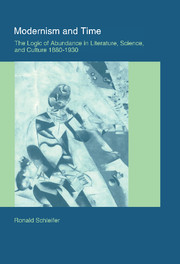Book contents
- Frontmatter
- Contents
- Preface
- Introduction:Post-Englightment Modernism and the experience of time
- PART I POST-ENLIGHTENMENT APPREHENSIONS
- PART II LOGICS OF ABUNDANCE
- 4 The natural history of time: mathematics and meaning in Einstein and Russell
- 5 Analogy and example: Heisenberg, linguist negation, and the language of quantum physics
- 6 The golbal aesthetics of genre: Mikhail Bakhtin and the borders of modernity
- Notes
- References
- Index
5 - Analogy and example: Heisenberg, linguist negation, and the language of quantum physics
Published online by Cambridge University Press: 22 September 2009
- Frontmatter
- Contents
- Preface
- Introduction:Post-Englightment Modernism and the experience of time
- PART I POST-ENLIGHTENMENT APPREHENSIONS
- PART II LOGICS OF ABUNDANCE
- 4 The natural history of time: mathematics and meaning in Einstein and Russell
- 5 Analogy and example: Heisenberg, linguist negation, and the language of quantum physics
- 6 The golbal aesthetics of genre: Mikhail Bakhtin and the borders of modernity
- Notes
- References
- Index
Summary
… there is no “being” behind doing, effecting, becoming; “the doer” is merely a fiction added to the deed – the deed is everything. The popular mind in fact doubles the deed; when it sees the lightning flash … it posits the same event first as cause and then a second time as its effect. Scientists do no better when they say “force moves,” “force causes,” and the like – all its coolness, its freedom from emotion notwithstanding, our entire science still lies under the misleading influence of language and has not disposed of that little changeling, the “subject” (the atom, for example, is such a changeling, as is the Kantian “thing-in-itself”) …
Friedrich Nietzsche, On the Genealogy of Morals (1969: 45)When Nietzsche speaks of “the misleading influence of language” in The Genealogy of Morals, he is opposing both positivist materialism and idealist subjectivism of the late nineteenth century, the “double deed” – or, in Bruno Latour's terms, “double task of domination and emancipation” (1993: 10) – of Enlightenment understanding examined in part I. He does so through the reconception of time, which Russell describes in relation to post-Newtonian physics, in relation to the eternal recurrence of the same. Nietzsche's method of transforming the settled self-evidence of received opinion does not simply offer other understandings of “force,” “subject,” “atom,” and even the “same” (das Gleiche). Rather, he temporalizes understandsing, meaning, and value by bringing together and confronting alternative and alternating discourses.
- Type
- Chapter
- Information
- Modernism and TimeThe Logic of Abundance in Literature, Science, and Culture, 1880–1930, pp. 184 - 207Publisher: Cambridge University PressPrint publication year: 2000



